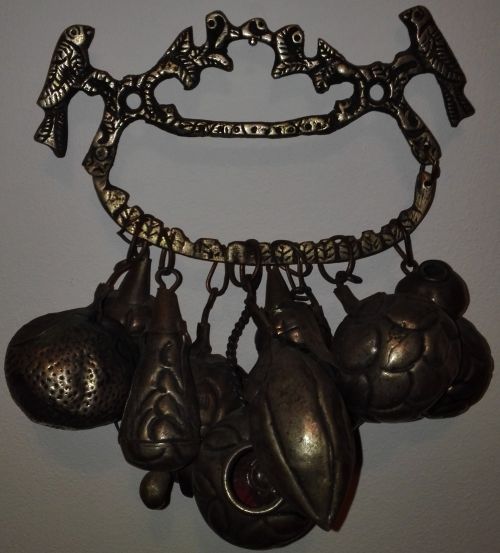- Category: Other
Penca de Balangandan

Antique Brazilian slaves jewelry.
This Penca de Balangandan is made of brass. The holder is 16.5 cm wide and fruits are up to 10 cm long. It has ten fruit charms.
Penca de Balangadan is a part of Brazil slaves history. This kind of jewelry was popular in the region of Bahia since 17th and 18th century. These amulets were traded as investment. Sometimes they were given to slaves by plantation owner as a reward for good behaviour or special services.
They were usually made of silver, brass, or copper. Most often they were pinned to a garment. Bigger ones were placed in doorways to ward off evil or for good luck.
Penca de Balangandan were full of meaning. Shape of a holder resembled slave ships. Two parrots, owls or hawks facing each other on a holder represented Africa and Brazil.
Charms hanging on the holder also had specific meaning. Many of them represented gods in Yoruba religion or Christian saints.
- Angola bread - a symbol of longevity.
Chains - a symbol of slavery.
Cabaca represented Christian saints and protectors of children, Cosmas and Damian.
Cashew representes God of thunder Shango (Chango or Xango), fire, justice, leadership.
Club represented God Obatala (Oxala or Ochala), the Sky Father and the creator of human bodies. He was responsible for birth of good spirits.
Grapes represented Goddess Oshum (Oxum), mother of freshwater, queen of waterfalls, goddess of innocence and sweetness. Goddess of fertility.
Fist or Figa were to ward off evil eye, jealousy and diseases.
Horseshoe was a symbol of happiness and good luck.
Corn, fruits and cereals symbolize fertility of the land.
Cocoa - cocoa plantation is were slaves worked.
Pigeon was a symbol of martyr Christian saints.
Sun represented the god of rainbow Oshunmare (Osumare).
Moon represented, in turn, god Oshosi (Oxosi), the spirit associated with the hunt, forests, animals, and wealth.
Crab represented Babalu-Aye (Omulu), the god of sickness and cemeteries.
Sword represented Oya (Iansa), goddess of winds, lightening, and violent storms, death and rebirth. Symbolizes the fight for survival and hard work.

